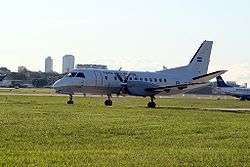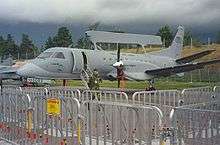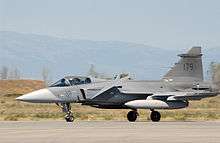Saab AB
 | |
| Publicly traded Aktiebolag | |
| Traded as | Nasdaq Stockholm: SAAB B |
| Industry | Aerospace and Defence |
| Predecessor |
SAAB/Saab AB (1937–68) Saab-Scania (1968–95) |
| Founded | Trollhättan, Sweden (1937) |
| Headquarters | Stockholm, Sweden |
Area served | Worldwide |
Key people | Håkan Buskhe (President & CEO) |
| Products |
Air Traffic Control systems Fighter aircraft Military aircraft Military systems Radars |
| Revenue |
|
|
| |
|
| |
| Total assets |
|
| Total equity |
|
| Owner | Investor AB (30.0%; 40.4% votes)[1] |
Number of employees |
|
| Subsidiaries | |
| Website |
saabgroup |
Saab AB (originally Svenska Aeroplan AB, later SAAB and Saab Group; ![]()
History
"Svenska Aeroplan AB (aktiebolag)" (Swedish for "Swedish Aeroplane Company Limited") (SAAB) was founded in 1937 in Trollhättan,[4] with the merger of Svenska Aero AB (SAAB) and Linköping based VASJA[5] the headquarters moved to Linköping. The style "Saab" replaced "SAAB" around 1950.[5]
Originally manufacturing aircraft, the company sought ways in which to diversify its business. In the late 1940s the company began manufacturing cars at its Saab Automobile division, based in Trollhättan. The first car was the Saab 92; full-scale production started December 12, 1949, based on the prototype Ursaab.[6]
In the late 1950s Saab ventured into the computer market with Datasaab.[4] The company was a result partly of the need to make a computer that would be small enough to mount in an aeroplane as navigational equipment. During the 1960s several computers were developed and sold to European countries, for uses such as banking. The aircraft computer (CK 37) was used in 1971 in the Viggen. The company was sold in 1975 to Sperry UNIVAC, while Saab retained its flight computer development.
In May 1965, the company name was changed to Saab AB to reflect its broad range of activities.[5]
In 1968 Saab AB merged with the Swedish lorry, bus and heavy-duty diesel engine manufacturer Scania-Vabis,[7] and became Saab-Scania AB.
In 1990 General Motors bought 51 percent of the car division Saab Automobile, and acquired the rest a decade later.
In 1991 Investor AB completed a leveraged buyout of Saab-Scania AB. Investor AB acquired all the outstanding shares in Saab-Scania for approximately SEK 21 billion.[8][9][10] Saab-Scania became a wholly owned subsidiary of Investor AB and the company was de-listed.[11]
In 1995 Saab-Scania was divided by Investor AB into two independent companies, de-merging into Scania AB and Saab AB. The intention by Investor AB was to broaden ownership in the two companies later.[12] Following the sale of 50% of the car division Saab Automobile AB to General Motors, the main reason behind the merger with lorry manufacturer Scania-Vabis in 1968 had disappeared.
Saab Military Aircraft and British Aerospace (now BAE Systems) formed in 1995 the joint venture company Saab-BAe Gripen AB, to manufacture, market and support Gripen internationally. This co-operation was extended in 2001 with the formation of Gripen International for the same purpose.[13]
From 1998 until 2005 the largest shareholder in Saab was the British aerospace company BAE Systems, following its acquisition of a 35% stake from Investor AB by its predecessor, British Aerospace. In January 2005, BAE Systems reduced its shareholding to 20%. Investor AB maintained a 20% share.
16 November 1999, Saab announced its intention is to purchase Celsius AB and the acquisition was concluded by early March 2000.[14]
In December 2005 Saab joined the Dassault nEUROn project as a major partner.
In October 2008 the company announced its intention to merge its operations with that of Simrad Optronics. The new unit will develop high-tech optronics products and will be headquartered in Norway, although other details of the new arrangement have not been finalized.[15]
In 2010 the company restructured from fifteen business units into five business areas; Aeronautics, Dynamics, Electronic Defence Systems, Security and Defence Solutions, and Support and Services. According to Saab the restructuring was undertaken to become more market and customer oriented.[16]
In March 2010, BAE Systems sold half of its 20% stake in the company to Investor AB, which then became the major shareholder.[17] In June 2011, the British company eventually sold its remaining stake bringing its 16-year involvement in Saab to an end.[18]
As of June 2012, Investor AB owns a 30% stake in the company (39.5% of the voting rights) and is the majority owner.
Aircraft production
The main focus of aircraft production is fighter aircraft. Saab has been making aircraft since the 1930s, and the jet predecessors of the JAS 39 Gripen were the Tunnan, the Lansen, the Draken and the Viggen. The last civilian models made by Saab were the Saab 340 and Saab 2000. Both were mid-range turboprop-powered airliners. The development and the manufacturing of these aircraft takes place in Linköping.
Organization
Aeronautics
Aeronautics offers airborne systems, related subsystems, Unmanned Aerial Systems (UAS) and aerostructures. The business area Aeronautics is responsible for airframe structures for JAS 39 Gripen, and whole sections for Airbus, Boeing and NH90; & system development of the JAS 39 Gripen and the Skeldar VTOL UAV. Aeronautics is also partner in the European joint UAV-project Dassault nEUROn, where Saab develop Avionics and is responsible for the overall architecture and design. Marketing and support of the JAS 39 Gripen fighter jet is also included in the Aeronautics business area.[19]
Dynamics
Dynamics offers ground combat weapons, missile systems, torpedoes, sensor systems, unmanned underwater vehicles and signature management systems, remotely operated vehicles for armed forces as well as civil security applications.[20]
Short range weapons offered include Carl-Gustaf, AT4/AT4 CS, STRIX and MBT LAW. Missile systems offered are RBS 70, RBS 23 and RBS 15.
Surveillance
Surveillance offers airborne surveillance solutions (including GlobalEye, Saab 2000 Erieye) AEW&C and fighter radar, ground-based and naval radar (including the Giraffe radar range), electronic warfare (including IDAS and ESTL) and combat systems and C4I solutions. [21]
Industrial Products and Services
Industrial Products and Services was established on 1 January 2015 and comprises the business units Combitech, Avionics Systems, Aerostructures, Traffic Management, Vricon as well as the development of product ideas that fall outside of Saab’s core business.
The business units within Industrial Products and Services differ from Saab’s other operations by their focus on business-to-business (B2B) customers or because they are not dependent on Saab’s principal end-customers. Other business areas within Saab have a customer base largely consisting of public authorities. With different customer groups come different management strategies and priorities. Opportunities to strengthen these operations in the long term are greater in the new organisation. Industrial Products and Services will work with individual growth strategies for each business unit.
Support and Services
Support and Services offer maintenance, integrated support solutions, field facilities, logistics and regional aircraft maintenance.[22]
Saab Aircraft Leasing leases and resells Saab aircraft to airlines. It completed 30 transactions in 2010.[23]
Saab Barracuda LLC
The Saab Barracuda LLC facility in Lillington, North Carolina, manufactures signature management products and provides customized services. Foremost among the camouflage, concealment and deception products is the Ultra Lightweight Camouflage Net System (ULCANS) which provides multi-spectral protection against visual, near infrared, thermal infrared and broadband radar detection. ULCANS is fielded with the U.S. Army and other Department of Defense organizations and is available in both woodland and desert versions.[24] Saab Barracuda is one of only two qualified suppliers of ULCANS in North America, and currently holds a competed $1.76 B contract, along with GMA Cover Corp.[25]
Saab Kockums
Products
Military aircraft
- Saab 17 (bomber/dive-bomber: manufactured 1941–1944, 323 built)
- Saab 18 (twin-engine bomber and reconnaissance aircraft: manufactured 1944–1948, 245 built)
- Saab 21 (twin-boom push-prop fighter/attack aircraft: manufactured 1945–1949, 298 built)
- Saab 21R (jet-powered version of Saab 21: manufactured 1950–1952, 64 built)
- Saab 29 Tunnan (first purpose-built jet fighter: manufactured 1950–1956, 661 built)
- Saab 32 Lansen (attack aircraft: manufactured 1953–1959, 450 built)
- Saab 35 Draken (fighter: manufactured 1955–1974, 644 built)
- Saab 37 Viggen (fighter/attack/reconnaissance aircraft: manufactured 1970–1990, 329 built)
- Saab JAS 39 Gripen (multirole fighter: introduced 1996, 219 built as of 2010)
- Saab 105 (twin engine trainer: manufactured 1963–1972, 192 built)
- Saab 340 AEW&C (airborne early warning and control aircraft: manufactured 1994–1997, 8 built)
Cancelled military aircraft projects
Civilian aircraft

- Saab 90 Scandia (32 passenger short-/medium-haul aircraft: manufactured 1946–1954, 18 built)
- Saab 91 Safir (single engine trainer: manufactured 1946–1966, 323 built)
- MFI-15 Safari/MFI-17 Supporter (single engine trainer: manufactured 1971 – late 70s, ca 250 built)
- Saab 340 (30–35 passenger short-haul aircraft: manufactured 1983–1999, 459 built)
- Saab 2000 (50–58 passenger high-speed turboprop airliner: manufactured 1992–1999, 63 built)
Experimental aircraft
Unmanned aerial vehicles
Missiles
- BILL 2 Anti-tank guided weapon
- KEPD 350
- MBT LAW
- RB 04 (anti-ship missile)
- Rb 05 (air-to-surface missile)
- RBS 23
- RBS-15 (surface-to-surface and air-to-surface anti-ship missile)
- RBS-70
- Meteor BVRAAM
Naval Combat Management Systems
Boats
Gallery
 Saab 18B (B 18B)
Saab 18B (B 18B)- Saab 32 Lansen (J 32B)
 Saab 91C (Sk 50C)
Saab 91C (Sk 50C) Saab 29 Tunnan (J 29F)
Saab 29 Tunnan (J 29F)- Saab 37 Viggen (SF 37)
 Saab Gripen (JAS 39)
Saab Gripen (JAS 39) Saab 340B
Saab 340B Saab 340 with Erieye radar
Saab 340 with Erieye radar
See also
- Datasaab
- Saab Automobile
- Saab training and simulation
- Saab Electric
References
- 1 2 3 4 5 6 7 "Annual and Sustainability Report 2016" (PDF). Saab Group. pp. 3, 20, 87, 88.
- ↑ "Saab's Griffin Caught Between a Rock and a Hard Place". Brand New. 2013-01-15. Retrieved 2015-01-08.
- ↑ "The history of Scania". Trucker Links. DK. Retrieved 2009-06-03.
- 1 2 "History and Background: Timeline, Video". About. US: Saab. 1980-01-01. Retrieved 2009-02-11.
- 1 2 3 Gunston, Bill (2005). World Encyclopedia of Aircraft Manufacturers, 2nd Edition. Phoenix Mill, Gloucestershire, ENG, UK: Sutton Publishing. p. 164. ISBN 0-7509-3981-8.
- ↑ Chapman, Giles (May 2009). The Illustrated Encyclopedia of Extraordinary Automobiles. Dorling Kindersley. p. 118. Retrieved 3 May 2012.
- ↑ "History of Saab". Swedecar. 1939-09-01. Retrieved 2009-02-11.
- ↑ "1984–1994", History, Investor AB .
- ↑ "Saab Automobile AB company", History, Funding universe .
- ↑ "Patricia AB launches a tender offer for Saab-Scania AB from Investor AB", Deal snapshot, AlacraStore .
- ↑ "Official financial history", Company overview, Scania .
- ↑ Annual report (PDF) (Investor report), Investor AB, Mar 31, 1998 .
- ↑ History of Saab, Swedecar .
- ↑ Saab has acquired further shares in Celsius, Saab, archived from the original on 2015-02-17 .
- ↑ "New Kid on the Block", Aviation Week & Space Technology, 169 (17): 16 .
- ↑ "Saab presents new operating and management structure". Saab. 2009-09-09. Retrieved 2010-08-03.
- ↑ "BAE Systems sells 10pc stake in Saab". The Telegraph. 5 Mar 2010. Retrieved 16 July 2012.
- ↑ O'Doherty, John (8 June 2011). "BAE offloads Saab aerospace stake". FT. Archived from the original on 27 April 2012. Retrieved 16 July 2012.
- ↑ "The business area Aeronautics". Saab. 2010-08-05. Retrieved 2010-08-05.
- ↑ "The business area Dynamics". Saab. 2010-08-05. Retrieved 2010-08-05.
- ↑ "Business Areas". Saab Corporate.
- ↑ "The business area Support and Services". Saab. 2010-08-05. Archived from the original on 2010-07-26. Retrieved 2010-08-05.
- ↑ "Saab Aircraft Leasing doubles aircraft transactions". Flight global. Retrieved 2011-02-27.
- ↑ "Introduction", Saab Barracuda, Saab .
- ↑ "USA'S Ulcans contract up to 173 bn for multi-spectral camouflage nets", Defense industry daily .
- ↑ Kerin, John (Sep 11, 2014), "Swedes launch desperate bid for Oz submarine project", The Australian Financial Review,
’As of July 2, Saab completed a full takeover of Kockums [the designer of Australia’s existing Collins class submarines] which is now Saab Kockums and the Swedish Kingdom now controls the intellectual property for the Collins class submarines’
. - ↑ Erripis, Ioannis K (Apr 15, 2013), "Saab's new stealth fighter program", Aerospace, Robot pig,
Saab is investigating the design of the next generation fighter that will someday eventually replace the Gripen. […] a small research program that SAAB is conduction with the University of Linköping. […] It looks similar to the Gripen and the main difference is the V-tail
. - ↑ Glowacki, Bartosz (Jul 13, 2010), "Saab plots bright future for Gripen programme", Flight international, Farnborough: Flight global,
Sweden's decades-long history of innovation in the aerospace sector is also evidenced by its Generic Future Fighter (GFF) concept. Developed by the Fluid and Mechatronic Systems division at Linköping University's department of Management and Engineering, the design has a Gripen-like fuselage with canards and canted tails.
|chapter=ignored (help) - ↑ Nordin, Peter; Jouannet, Christopher; Krus, Petter (Aug 30, 2011), Flumes Flies a Demonstrator of a Generic Future Fighter Aircraft, SE: LIU
Bibliography
- Gunston, Bill (2005). World Encyclopedia of Aircraft Manufacturers (2nd ed.). Phoenix Mill, Gloucestershire, ENG, UK: Sutton Publishing. ISBN 0-7509-3981-8.
- MacPhaily, Doug; Östberg, Mikael (2003), Triple Crown BT-9: The ASJA/Saab Sk 14, A Pictorial Essay (in English and Swedish), San Josef, BC/Dundee, On: DCF Flying Books
External links
| Wikimedia Commons has media related to Saab military planes. |

